Waterproofing leather shoes - the right way to do it
Waterproofing protects sensitive leather shoes from moisture and dirt. What you need to pay attention to, which waterproofing spray is the most suitable and how often leather shoes should be waterproofed – you'll learn all of this and much more here.
What does waterproofing shoes mean?
Waterproofing means treating materials to make them more resistant to external influences such as moisture and dirt. Especially shoes are prone to these in wet weather, and can be treated with special waterproofing sprays. Waterproofing coats the surface of the shoes with a film that protects them from dirt and moisture. The water-repellent film lets the water roll off, and also prevents the ingress of dirt. Accordingly, waterproofing is an important element of leather shoe care.
Should leather shoes be waterproofed?
Yes, absolutely. Whether women's boots or men's sneakers: especially during the cold, wet time of the year, it is very important to properly waterproof leather shoes to prevent water or salt stains and the ingress of dirt. Particularly open-pored, fine shoe leathers such as suede and nubuck leather that are inherently especially prone to harm caused by moisture and dirt should be waterproofed. Waterproofing is generally a good idea for shoes made from all types of leather, such as, for example:
- Brushed leather
- Suede
- Nubuck leather
- Nappa leather
- Smooth leather
- Patterned leather
Rain, sludge snow: in the autumn and winter, leather shoes are especially often exposed to moisture and dirt. Protecting them with a waterproofer is particularly important now.
What effect does waterproofing have on shoe leather?
Although shoe leather is water-repellent, it is not one hundred percent waterproof, compared to other materials, because during the manufacture of high-quality leather shoes, the surface's pores are intentionally left open to ensure that the leather retains its inherent breathability. A properly applied waterproofer forms a water-repellent film, but also ensures that the leather retains its breathability, as it does not clog the pores.
Waterproofing has the following effects on leather shoes:
- Water-repellent: Waterproofers form a protective coating on the leather that repels water and dirt. This prevents the leather from being damaged by rain, snow or puddles, or from absorbing water.
- Dirt-repellent: The waterproofer can make it more difficult for dirt and other substances to permeate the leather. This often makes it easier to remove stains, and to prevent them.
- Longer lifespan: Regular waterproofing makes the leather look beautiful for longer, and more durable.
- Prevents mould: Mould may form on thoroughly wet shoes. The waterproofer's water-repellent film prevents this.
- Breathability: Good waterproofers maintain the leather's breathability so that it can continue to breath and feels nice but is also protected.
Careful, though: Depending on the type and ingredients, waterproofers can have different effects and slightly change the look and feel of the leather. They can make them shine, for example, or slightly darken its colour. It is therefore a good idea to try out the waterproofer on a small, non-exposed area of the shoe first (e.g. on the inside of a heel) to check that it has no unwanted effects on the leather.
Instructions: Five steps to waterproofing leather shoes correctly
For clean and perfectly protected leather shoes, ensure that you perform the following steps in the right sequence. These differ, depending on whether you are waterproofing smooth leather or suede/brushed leather shoes – below, you'll find instructions for both leather types.
Waterproofing smooth leather shoes
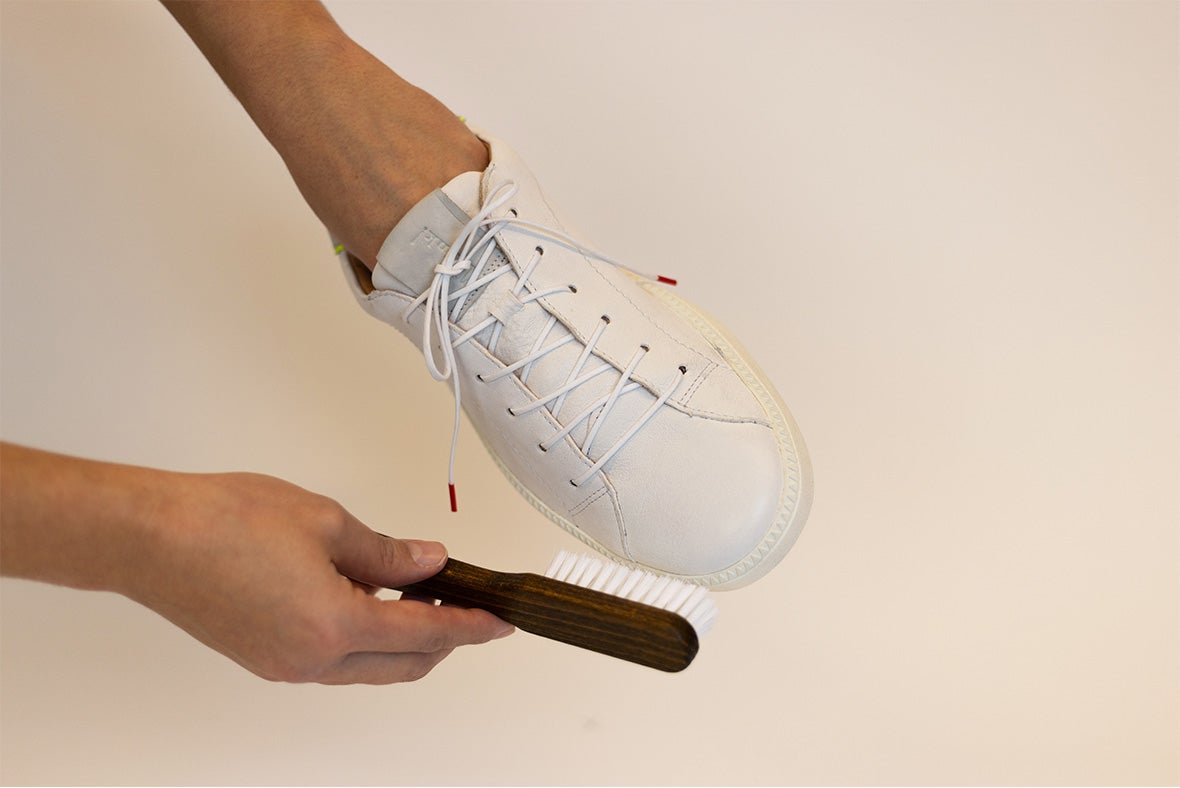
1. Remove any dirt: Remove any remaining dirt with a shoe brush or a damp cloth.
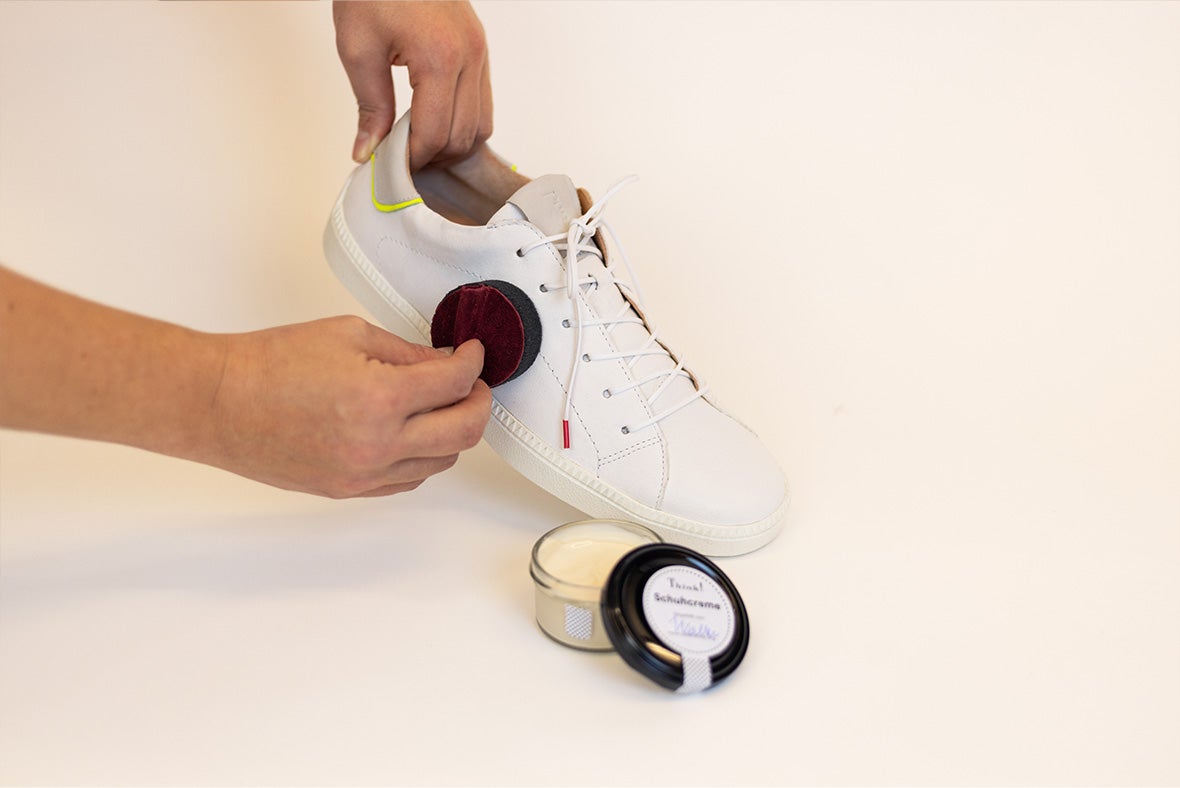
2. Apply shoe cream: Apply shoe cream (transparent or in the leather's colour) using even, circular motions. Be thorough, and don't leave any of the colour visible.
3. Working in: Afterwards, go over the material again with a cotton cloth or a horsehair brush (extremely soft brush). Leave the shoes to dry for a few minutes.
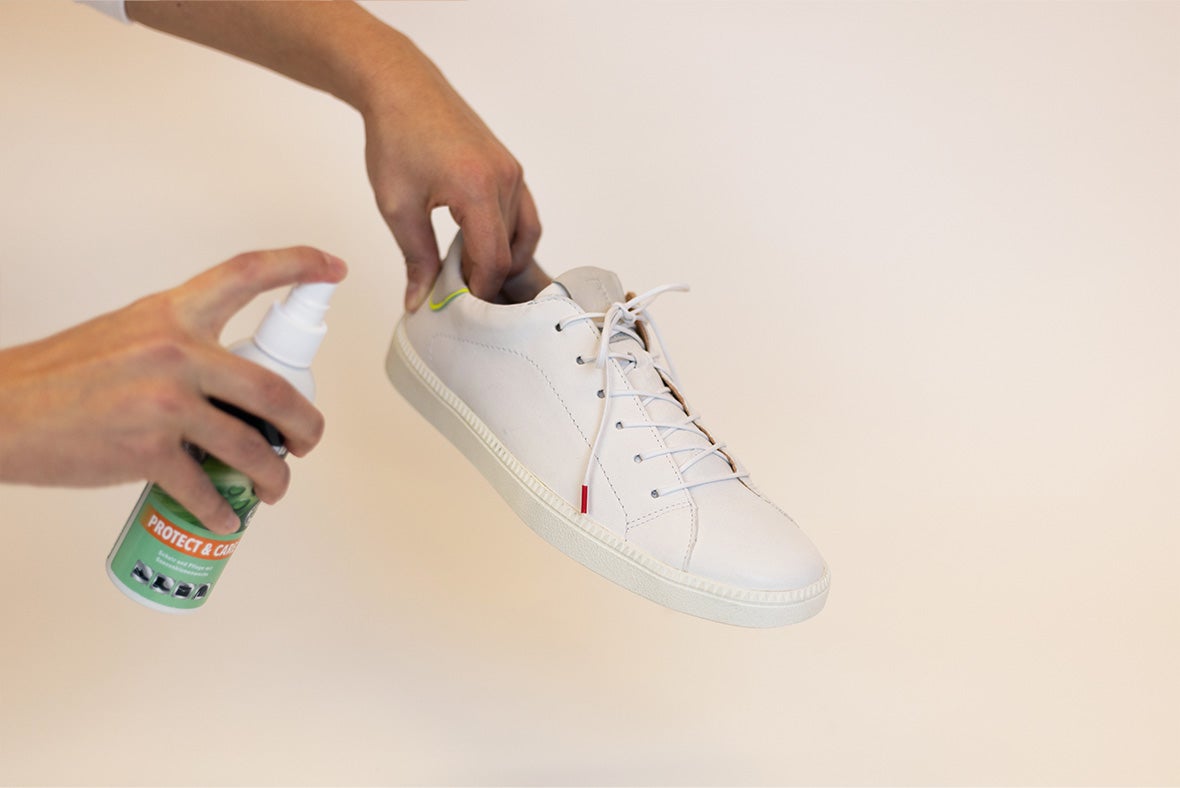
4. Waterproof: Now waterproof the shoes with a waterproofer suitable for your shoes' material type. Due to aerosols, you should do this outdoors only, or use a CFC-free pump spray.
- Follow the manufacturer's recommendations and coat each shoe in a thin layer, spraying from a distance of 20-30cm.
- Never apply so much spray that drops form and the shoe is wet through!
- Ensure that all parts of the shoe are covered – including the seams on the sole edges and the shoelaces should be protected against moisture and swelling.
- A thin layer is sufficient - you do not need to repeat the process.
5. Leave to dry: Leave the shoes to dry according to the manufacturer's recommendations – preferably with newspaper stuffed inside them – for up to 24 hours, or at least overnight.
Waterproofing suede or brushed leather shoes
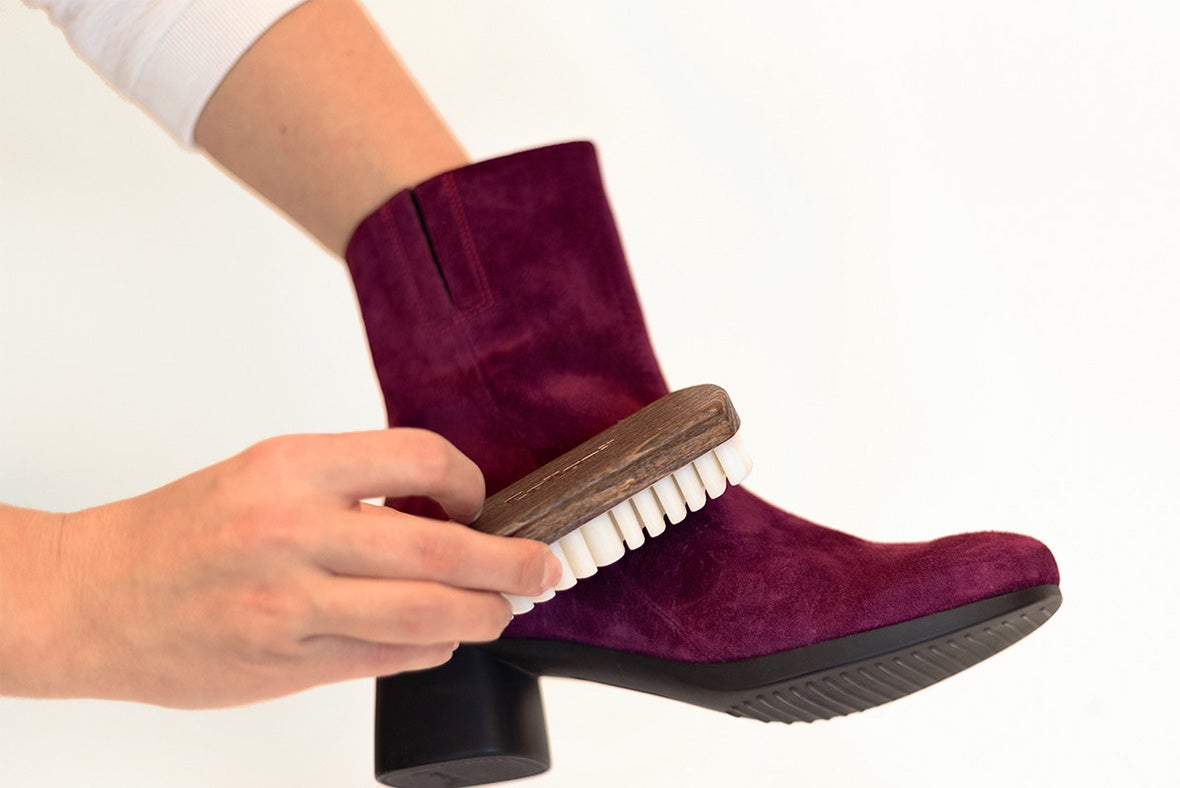
1. Remove any dirt: Remove any remaining dirt with a crepe or horsehair brush.
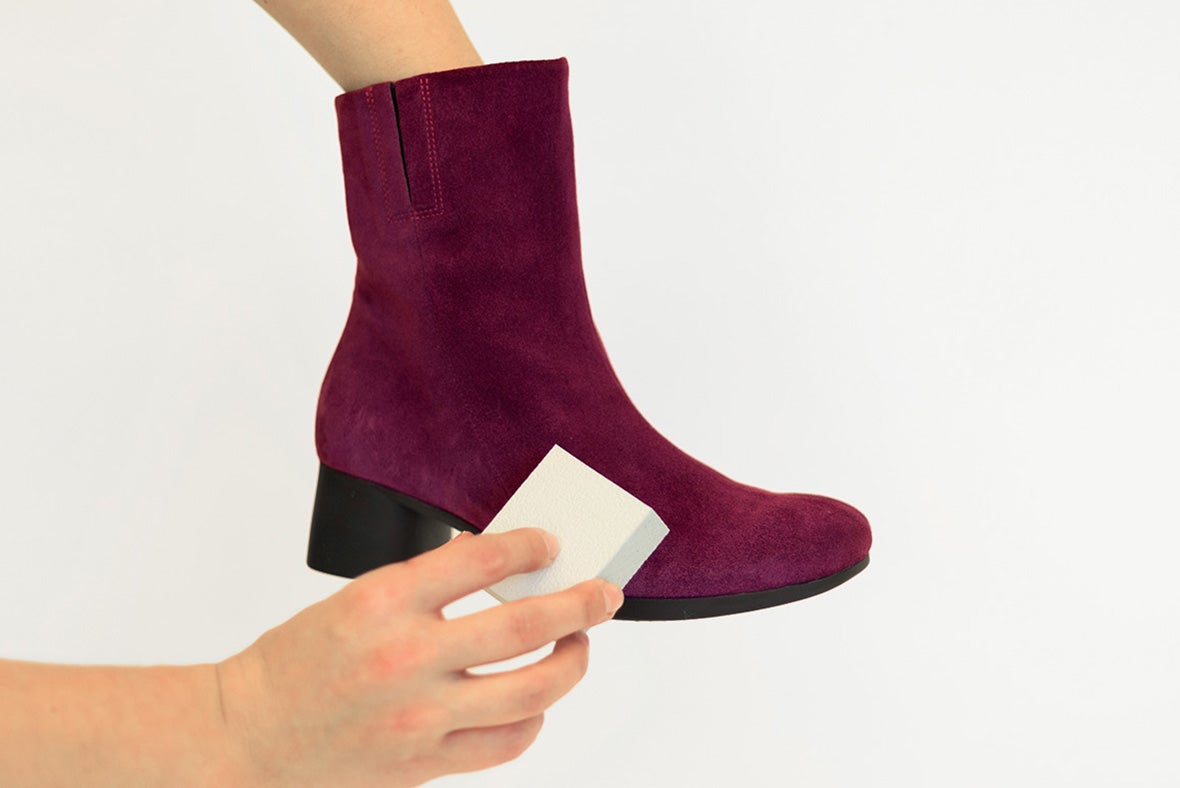
2. Roughen the leather: Roughening the leather with a special suede/rough leather brush not only removes deeply ingrained dirt from the material but also re-fluffs the pile, thereby restoring its typical velvety texture. Important: Unlike smooth leather, you do not apply cream to suede or brushed leather!
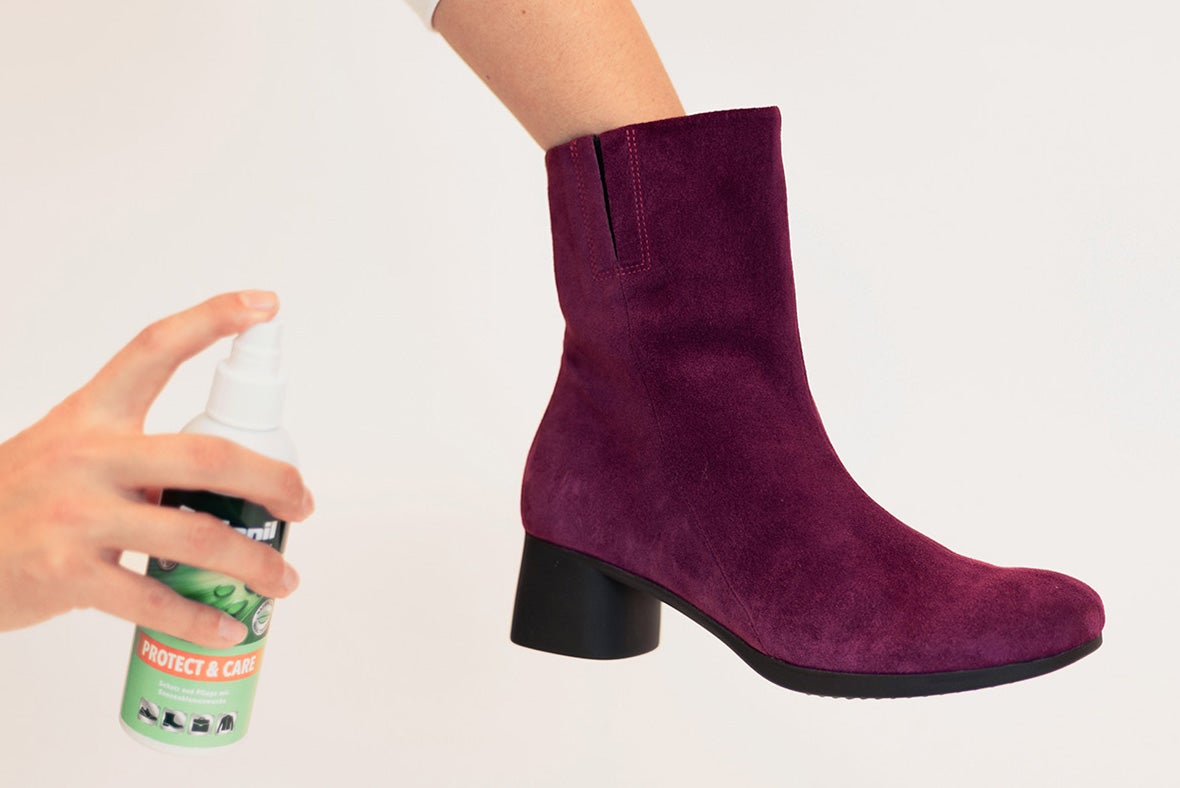
3. Test waterproofer: Apply the waterproofer to a small, non-exposed area of the shoe (e.g. on the inside of the heel) to see whether and how the waterproofer changes the look and feel of the leather. Only continue if you are satisfied with the result.
4. Waterproof: Now apply the waterproofer, covering the entire shoe in a thin layer, in the same way it is applied to smooth leather (see above).
5. Leave to dry: Leave the shoes to dry according to the manufacturer's recommendations – preferably with newspaper stuffed inside them – for up to 24 hours, or at least overnight.
How often should leather shoes be waterproofed?
How often you should waterproof your shoes depends on how often you wear them and the time of the year. In wet autumn weather and in winter, it is even a good idea to apply waterproofer 2–3 times a week. Background information: Frequently wearing shoes gradually erodes the waterproof coating – above all in places where movement causes a lot of wear and tear (such as the typical crease caused by walking). You should therefore definitely waterproof shoes you wear often more frequently. The same applies if they have become wet through (e.g. through rain or snow) – first let them dry properly, then waterproof them again.
The right shoe waterproofer
Waterproofers are available in the form of spray or foam. When you buy waterproofer, you should first of all make sure that it is suitable for the material your shoes are made of. This is usually stated on the packaging. Furthermore, it's a good idea to choose a pump spray that is CFC-free, as this is also safe for indoor use (as it does not exude any harmful vapours you might breathe in). There are also eco-friendly products, such as Collonil's Organic line, for example. In addition, only solvent-free or water-soluble waterproofers should be used on leathers with special finishes.
Factors such as eco-friendliness and health aspects play a role when choosing a waterproofer.
Is it really necessary to use a waterproofing spray for shoes?
Yes, you should use a waterproofing spray or foam if the lifespan and look of your shoes are important to you.
Do you use the same spray for shoes made of smooth leather and suede?
Yes, most waterproofers are suitable for both types of leather.
Can you also use hairspray to waterproof shoes?
Definitely not! Hairspray clogs the leather's pores and makes it porous. You should also never use anything greasy or oily, as this also clogs the pores. We would also advise against the use of home remedies and other alternatives. A professional waterproofer perfectly meets the special needs of leather and therefore the best choice.
Frequently asked questions about waterproofing leather shoes
Are there leather shoes that shouldn't be waterproofed?
All leather shoes should be waterproofed. However, only solvent-free or water-soluble waterproofers should be used on leathers with special finishes. On suede or brushed leather shoes, apply the waterproofer to a small, non-exposed area to see whether and how the waterproofer changes leather's properties.
Have new leather shoes already been treated with a waterproofer?
Not necessarily. At Think!, however, all shoes that are made of vegetable-tanned leather or suede and brushed leather, for example, have been treated with a waterproofer before they leave our factory. However, you should definitely reapply waterproofer in the first few weeks – especially during the cold season.
Can you waterproof smooth leather shoes?
Yes, absolutely. You can find detailed instructions in the section Waterproofing smooth leather shoes.
Does moisture cause irreparable damage to leather shoes?
No. However, what is important is to stuff the insides with a material that absorbs moisture (e.g. newspaper), and to leave them to dry out completely. Do not put the shoes on top of a radiator to dry them (as this could make the leather brittle or change its shape), but in a dry place at room temperature.
How do you treat leather shoes before you wear them for the first time?
You should waterproof new leather shoes before you wear them for the first time (you can find detailed instructions in this section ) to protect them from moisture and dirt. As a shoe care measure, you can treat smooth leather shoes with a shoe cream first.
What comes first: applying shoe cream, or waterproofing?
Never use shoe cream on suede or brushed leather. Apply shoe cream to smooth leather first before covering it with a water-repellent layer of waterproofer.
What alternatives are there to waterproofing spray for shoe waterproofing?
We do not recommend the use of alternatives such as hairspray or home remedies for the treatment of leather shoes; you should only use the kind of spray or foam waterproofer sold in shoe shops. They are designed to perfectly meet the needs of the material and achieve the best results when it comes to retaining the beauty of your leather shoes and extending their lifespan.
Should you apply several layers of waterproofing spray when waterproofing shoes?
That's not necessary – on the contrary, less is indeed more when it comes to waterproofing shoes. It is a much better idea to frequently apply a thin layer of waterproofer to your shoes.


